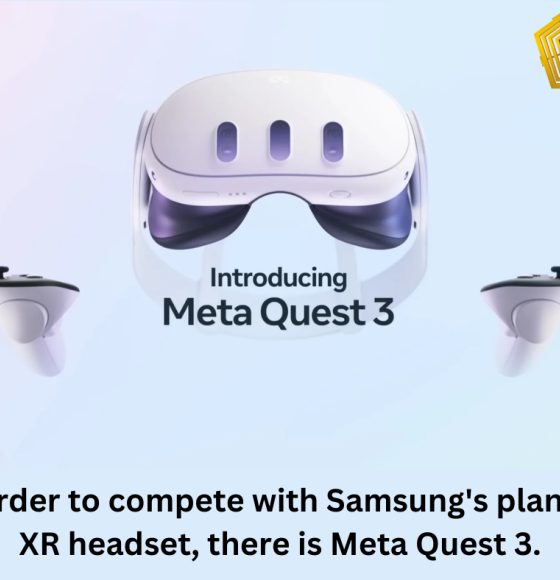A virtual and mixed-reality headset called Quest 3 has been released by Meta. It is comparable to the Apple Vision Pro and the future Samsung XR headset. It replaces Quest 2, which was published in 2020. The Quest 3 features better software, new controllers, smaller and more comfortable headsets, new cameras, and faster performance as compared to the previous iteration. The Quest 3 is available in the US for $499 for the 128GB model and $649.99 for the 512GB model, according to Meta. Pre-orders for Meta’s revolutionary VR and MR headgear are now being accepted, and the company will begin shipping them on October 10, 2023.
Larger field of view, smaller lenses, and sharper screens:
The Quest 3 has two LCD panels, one for each eye, with a resolution of 2,208 × 2,064 pixels and a refresh rate of 120Hz. In comparison to the Quest 2, this resolution offers 1,218 PPI, a 30% improvement in resolution. The 120Hz refresh rate mode, however, is still in the testing phase. You must utilize a 90Hz refresh rate for stable functioning.
This model’s field of view has been increased by 15% to 110 degrees horizontally and 96 degrees vertically on these displays. These lenses have a thinner optic profile than the pancake-style lenses seen in Apple’s mixed reality headset.
Qualcomm Snapdragon XR2 Gen 2 processor-based:
The Qualcomm Snapdragon XR2 Gen 2 processor powers the Quest 3. Meta claims that it provides twice the GPU performance of the Snapdragon XR2 Gen 1 used in the Quest 2. The new SoC brings “enough power to support heavy applications like fast-action gaming, seamless full-color, high-resolution passthrough, and so much more,” and the new GPU offers “faster load times and more seamless gameplay.” In addition to the previously mentioned 128GB and 512GB storage options, there is 8GB RAM inside.
Four IR cameras, one depth sensor, and two full-color cameras:
The Quest 3 includes two RGB cameras and a depth sensor for “improved depth and resolution” as opposed to the previous model. The strong SoC and the new cameras enable mixed reality passthrough. This implies that, like the Apple Vision Pro, you can see what is around you in the actual world through the headset. The passthrough latency, according to Meta, is only 12 milliseconds. We’ll cover this in more detail later. The headset also has four IR cameras for gesture recognition, which does away with the need for controllers.
Smaller but heavier and more comfortable headset:
The Quest 3 is heavier than the Quest 2, while having a smaller footprint (515 grams as opposed to 503 grams). The new headgear, according to Meta, promises “more comfortable wear,” though. A flexible soft strap on the Quest 3 “accommodates a variety of head shapes and hairstyles.” A firm strap, however, is available separately for a fee. To “improve comfort and field of view,” these straps let you move the headset farther away from or closer toward your face.
New games, redesigned controllers:
It includes two Touch Plus controllers for the Quest 3. These lack the ring that the Touch controllers that come with the Quest 2 have for tracking the controllers in 3D space. Therefore, it is currently unknown how Meta is following the new controllers in three dimensions. The Touch Plus controllers, according to Meta, feature greater haptic feedback, making for a better gaming experience.
Speaking of games, the Quest 3 is compatible with the entire Quest 2 game library, which includes more than 500 VR games. In addition, Meta is releasing three AAA games together with this headgear. Asgard’s Wrath and Assassin’s Creed Nexus are two of them. The Quest 3 is largely being marketed by the firm as a gaming gadget. But Meta claims that the new headgear will be excellent for exercising as well.
Similar to Quest 2’s battery life:
Depending on the activity you are working on, the Quest 3 delivers 1.5 hours to 2.9 hours of usage on a single charge, according to Meta. These numbers are comparable to those for Quest 2. The new headset, according to the manufacturer, can charge from zero to one hundred percent in about 2.3 hours. Thankfully, an 18W power adapter is included in the box. Wi-Fi 6E is one of the connectivity possibilities, and it’s important to note that the headset lacks eye tracking.
What will the new Samsung XR headset mean by Meta Quest 3?
The Apple Vision Pro was already a competitor for Samsung’s planned XR (Extended Reality) headset, which the company is creating alongside Google and Qualcomm. The release of Meta Quest 3 intensifies the rivalry for the Samsung XR. It will compete not just with the Quest 3 in terms of pricing and features, but also with the Apple Vision Pro in terms of features.

















